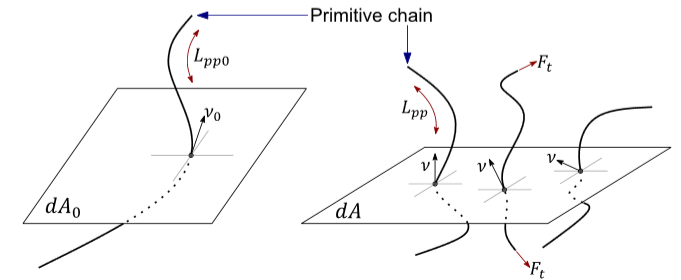 Viscoelasticity characterizes the most important mechanical behavior of elastomers. Understanding the viscoelasticity, especially finite strain viscoelasticity, of elastomers is the key for continuation of their dedicated use in industrial applications. In this work, we present a mechanistic and physics-based constitutive model to describe and design the finite strain viscoelastic behavior of elastomers. Mathematically, the viscoelasticity of elastomers has been decomposed into hyperelastic and viscous parts, which are attributed to the nonlinear deformation of the cross-linked polymer network and the diffusion of free chains, respectively. The hyperelastic deformation of a cross-linked polymer network is governed by the cross-linking density, the molecular weight of the polymer strands between cross-linkages, and the amount of entanglements between different chains, which we observe through large scale molecular dynamics (MD) simulations. Moreover, a recently developed non-affine network model (Davidson and Goulbourne, 2013) is confirmed in the current work to be able to capture these key physical mechanisms using MD simulation. The energy dissipation during a loading and unloading process of elastomers is governed by the diffusion of free chains, which can be understood through their reptation dynamics. The viscous stress can be formulated using the classical tube model (Doi and Edwards, 1986); however, it cannot be used to capture the energy dissipation during finite deformation. By considering the tube deformation during this process, as observed from the MD simulations, we propose a modified tube model to account for the finite deformation behavior of free chains. Combing the non-affine network model for hyperelasticity and modified tube model for viscosity, both understood by molecular simulations, we develop a mechanism-based constitutive model for finite strain viscoelasticity of elastomers. All the parameters in the proposed constitutive model have physical meanings, which are signatures of polymer chemistry, physics or dynamics. Therefore, parametric materials design concepts can be easily gleaned from the model, which is also demonstrated in this study. The finite strain viscoelasticity obtained from our simulations agrees qualitatively with experimental data on both un-vulcanized and vulcanized rubbers, which captures the effects of cross-linking density, the molecular weight of the polymer chain and the strain rate.
for LaTeX users @article{YLi2016-88,
author = {Y. Li and S. Tang and M. Kr\"oger and W. K. Liu},
title = {Molecular simulation guided constitutive modeling on finite strain viscoelasticity of elastomers},
journal = {J. Mech. Phys. Solids},
volume = {88},
pages = {204-226},
year = {2016}
}
\bibitem{YLi2016-88} Y. Li, S. Tang, M. Kr\"oger, W.K. Liu,
Molecular simulation guided constitutive modeling on finite strain viscoelasticity of elastomers,
J. Mech. Phys. Solids {\bf 88} (2016) 204-226.YLi2016-88
Y. Li, S. Tang, M. Kr\"oger, W.K. Liu
Molecular simulation guided constitutive modeling on finite strain viscoelasticity of elastomers
J. Mech. Phys. Solids,88,2016,204-226 |
![]() mk@mat.ethz.ch
1 out of 810 entries requested
[H-factor to-date: > 0]
mk@mat.ethz.ch
1 out of 810 entries requested
[H-factor to-date: > 0]

mk@mat.ethz.ch 1 out of 810 entries requested [H-factor to-date: > 0]